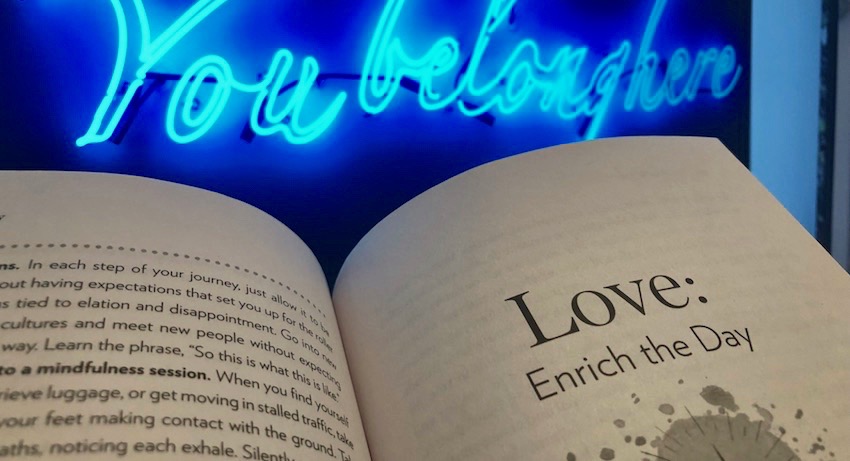Leadership posts

It Is Not About You, It Is About Love
Posted by Laurie J Cameron
Tonight, on this night of love, I will join teachers Tara Brach and Jack Kornfield here in my hometown of Washington, D.C. for a closing gathering after our two-year meditation teacher training journey. In all of the topics, practices, research, stories and poems we shared in our cohort for the last few years, at the foundation of it all was always love.
One of the five sections in my book is entirely devoted to Love. Jack Kornfield says, “the point of mindfulness is not to perfect yourself; it is to perfect your love.” It’s more than a positive emotion: Love is a positive state that you can cultivate, and it permeates every aspect of life.
"Mindfulness skills and mindsets can support you in perfecting your love by helping you look at yourself closely and allowing your heart to open. Our habits of mind often get in the way of experiencing love in a clear, embodied way. To love yourself and others requires that you cut through the expectations, assumptions, comparisons, worries, fears, or sense of unworthiness that block your ability to connect. It takes conscious effort to be willing to see and challenge the stories we tell ourselves—but it’s worth it to take down the walls and free ourselves to embrace imperfections, forgive, and love fully. You can learn concrete ways to strengthen your connection with your family, your friends, and most of all, yourself. Relationships are the connections in your life that have the potential to be “a sacred refuge, a place of healing and awakening” as Tara Brach puts it. She emphasizes the idea of looking deeply at one’s self and at one another: “With each person we meet, we can learn to look behind the mask and see the one who longs to love and be loved. Most of us need to be reminded that we are good, that we are lovable, that we belong.” The skills and qualities of mindfulness can guide you toward seeing with fresh eyes and living with compassion and kindness.
Mindful training in love is never done. But you will notice it comes more easily as you open your heart with deliberate practices. When you’re present with loving awareness, you can allow the joy that arises from loving to unfurl. It begins with learning to love yourself, and expands out from there, in ever-widening circles.
We all yearn for connection—to be seen, appreciated, and loved. Yet in our society, many of us feel isolated and are touch-deprived. Moments of transition can be an easy way for you to connect and be more present for those you care about. In addition to the benefit of demonstrating to the person that “you matter, and I care,” a mindful greeting with a hug can make you and the other person happier and healthier. A hug increases levels of the “love hormone” oxytocin, and reduces the harmful effects of stress, which can benefit your heart health and more. One study from the University of North Carolina found that women who hugged their spouse or partner frequently (even for just 20 seconds) had lower blood pressure. Often when we are welcoming someone—whether home from a long day, to a planned dinner, or even to an important meeting—that person is coming from crawling traffic, a difficult encounter, or another potentially stressful situation. A welcoming physical gesture conveys safety and trust. Neuroscientist Michele Noonan says a warm touch can create an instant attitude makeover and can ease a person’s level of irritation because the sensation triggers the insula, a region in the brain involved with emotional processing. That’s why some experts suggest that to build connection, we hold our hug until both bodies feel relaxed.
We received training on this at Thich Nhat Hanh’s monastery at the Magnolia Grove Meditation Practice Center in Mississippi, when the nuns and monks taught us the hugging meditation as part of a family mindfulness ritual. Of course, the hugging meditation can be done anytime, not just as a greeting. The practice builds on the mindfulness qualities of awareness, generosity, and joy. First you bow and recognize the presence of each other—for example, walking to the door, making eye contact and saying “Welcome home,” or standing and truly acknowledging that someone has arrived to join you for a meal. Then each of you take a conscious breath to bring yourself fully into the moment. Next, you open your arms and hug, holding each other for three in-and-out breaths.
With the first breath, you are aware that you are present in this very moment and that you are happy. With the second breath, you are aware that the other is present in this moment and that you are happy about this as well. With the third breath, you are aware that both of you are here together, right now, and you feel deep gratitude and joy for your togetherness. After the third breath, release the hug and bow to each other to express your thanks. As Thich Nhat Hanh teaches, this process makes the message clear: “Darling, you are precious to me.” "
Excerpted from The Mindful Day, National Geographic, 2018.
On this Valentines Day, and every day, remember that loving presence is the ultimate loving gift you can give, and receive.